
32 minute read
100 glorious years: RC Calcutta
Rasheeda Bhagat
It has a lineage, pedigree and a hoary past that will not be easy to match by any Rotary club in the world. Did you know that the Rotary Club of Calcutta, RID 3291, which completes 100 years this year, played a role in getting the Howrah Bridge over the River Hooghly being constructed? Not only that, for long after this, one of its club members was on the government committee formed for the upkeep of the bridge.
Advertisement
The club had the honour of being addressed by none less than Mahatma Gandhi, and though memories are hazy about what exactly he said, there is one comment that is quoted over and over again. Apparently all the bada sahibs of Calcutta, who were the members of this prestigious club, agreed to their luncheon meeting being an entirely vegetarian one, in honour of the vegetarian Gandhi. And the Mahatma said (undoubtedly with that famous twinkle in his eye), “I notice today the Rotarians are eating a Bengali widow’s luncheon!”
Also, as past president Ritwik Gupta told Rotary News, a million dollars were donated through two $500,000 cheques, to the Missionaries of Charity, even after Mother Teresa’s death by an “American woman, who I think was the wife of a Rotarian. She gave the cheques for two successive years and insisted that RC Calcutta hand it over to the charity. Later, Sister Nirmala, who headed this





charity, said that we are getting enough donations from other sources too, so please ask this lady to give the money to other charities too.”
As Rotary across India gets enthused to celebrate the 100 th year of Rotary in our country, at the celebratory event planned on New Year’s eve by the club there is music and dance, food and fun. I manage to talk to some of the illustrious past presidents of the club such as Gupta, PDG Prabhat Rohatgi, Dr S K Sharma, Nilima Joshi, and of course the present club president Purnendu Roy Chowdhury.
This is the club that also wears the proud label of sending the first RI President from India in Nitish Laharry, who became a member in early 1926, and within a year went on to become its first Indian secretary. The club’s history book describes him “as a quiet and even a shy young man” who got into the thick of Rotary right “from the start and The way the villagers accept what
we Rotarians gave, showed they
valued our help… a single blanket
was a big deal to them.
Amit Ghosh, club member



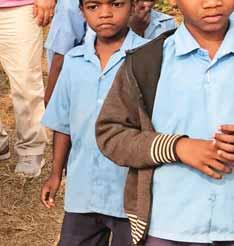
during his first two years as a Rotarian, apart from being secretary, initiated a Rotary Education Committee, formed by the nucleus for a club library and edited The Chaka,” the club bulletin.
As I ride in club member Amit Ghosh’s car from the airport to the inaugural of a club project — gifting a camera worth `25 lakh to a local hospital for preventing blindness in premature babies — he talks about how he got “Rotary service” injected into his blood. Barely four years ago, as the head of finance in a Tata company, “I could walk into the room of the joint secretary, Ministry of Steel, by just waving my Tata Steel ID, saying I want to negotiate for this subsidy or that. But going to a village in the Sundarbans and distributing dictionaries to the schoolchildren, my eyes opened to the fact that people also live like this. And everything is not related to the North Block or some hi-fi bank in Mumbai.”
That single experience gave the man who has held the post of CFO in various Tata group companies, “the
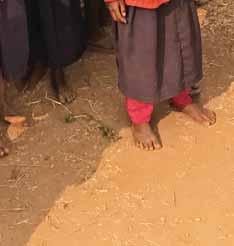

RC Calcutta President Purnendhu Roy Chowdhury (far left) and Centennial Committee Chairman Saumen Ray (R) with tribal children of Santhali in Purulia. A boarding school is being built here by the club to accommodate 400 young students.


RID Bharat Pandya and Madhavi at the club’s charter day celebrations on Jan 1, 2020.
The genesis of RLI
One of the oldest living members of RC Calcutta, 86-yearold PDG Prabhat K Rohatgi, who has sponsored the Centennial Bell, on the eve of RC Calcutta’s marking of its 100 th charter day, takes me down memory lane on the club’s hoary past.
He became DG in 1998–99; “actually for a long time I refused to be a Rotary office holder. But as a Rotarian I found that what many Rotarians lacked was basic knowledge — what they could get out of Rotary and what they could give to Rotary.”
He found that many people joined Rotary, stayed for a while, found nothing to satisfy them and left. “That was happening, and RI was very worried. So I said let us put together an interesting training programme or a course to train our Rotarians, who were interested, about what is Rotary, its rules and regulations that they should conform to, and which in return, would give them a lot of benefit.”
Thus was born RLI or Rotary Leadership Institute, which offers 3–4 different courses every year and about 150–200 Rotarians get trained through these courses every year. “In 10 years, I can say, RLI must have trained about 2,000 Rotarians who know something about Rotary. Every now and then I have people calling up to say thank god I did the course.”
Now there are three courses and “RI has accepted RLI as an educational adjunct. It’s not part of Rotary but an adjunct of RI, and is known for giving the right kind of Rotary information.”
idea of real India… and the value one dictionary, or one solar lamp or mosquito net, has for many people. The way the villagers accept what we Rotarians gave showed they valued our help… a single blanket was a big deal to them,” says Ghosh.
In the Sundarbans, “we have multiple projects, it takes 5–6 hours to go there from Kolkata, two hours by car and another three or more hours by river.”
Totally hooked to the service projects of his club, he talks about a PHC (public health centre) where RC Calcutta has given a lot of medical equipment and “solar power for the refrigerator where our polio drops are stored. And once you give one person or organisation solar power, the question comes why not to another.”
But isn’t there electricity available in a place not that far from Kolkata, I ask him. “Yes, the power line is indeed there, but with that electricity, a 100- watt bulb burns like a mere candle,” he says. There were two higher secondary schools in the village without power, as well as a police thana which the
Rotarians have lighted up. “Last year, when we visited the police station, chai cups were immediately offered. Thanks to our solar power, you can see the police station right from the river and the policemen told us because of the huge glass lantern that burns there, the crime rate has fallen in that small village. This is the impact of electrification,” says Ghosh.
In another village in the Sundarbans, along with a German club and a global grant, RC Calcutta has put up a night shelter for the family members accompanying pregnant women coming for delivery. “In these villages full-term pregnant women come first on a bullock cart and then through a river to the PHC, which has a labour room and a room for the mother and newborn made of RCC sheets.” But the persons accompanying her, the husband and other children who also come along, had earlier no place to sleep. Apart from the night shelter, the club has installed LED bulbs and facilities for autoclaving the surgical equipment. All of this is solar powered.
Next on the club’s list is giving incubators for premature babies… Only when you have been
there as a good member for
three years, and get involved,
you will never leave Rotary!
Prabhat Krishna Rohatgi Past District Governor
“I simply love the projects-part of being in our club,” gushes Ghosh.
Well, which member doesn’t, I wonder, as I interview a group of illustrious past presidents of the club, all of whom have left an indelible mark on this 100-year-old-club.
I ask past president Ritwik Gupta, a member of RC Calcutta for 33 long years, who led the club in 2014–15, how difficult was it to serve as president in a club which has so many notable projects going. “Not difficult at all… it just took everything from me,” he smiles. “You just give yourself for one year to your club, that is not difficult!”

Club President Chowdhury makes a contribution to the Gorkha monks at Sonada village in Darjeeling to help them buy food and winter wear.
PDG Prabhat K Rohatgi is more senior than him, having joined the club in 1958, when he was only 26, and is considered a “living legend” in the club. He joined Rotary “because in our family Rotary was held in high esteem.” His father too was a president of the club. Initially, the young man wasn’t very comfortable to be in a club “full of seniors and uncles,” but soon embraced Rotary so much that his wife Shashi loves to introduce herself as his “second wife”; the first one being Rotary.
Now set to become the president of her club, RC Calcutta Victoria, she complains that for a long time he did not allow her to join Rotary and his club. Asked why, Rohatgi smiles and says: “Because only one rickshawman pulls a rickshaw.”
This veteran has “very many memories” of Nitish Laharry. “A short while after my induction, I got a call from Laharry — he was called Ned Laharry — who said I want to talk to you.”
So Rohatgi went to his office which was on the first floor of Metro cinema “which has now become a clothing store. He was a very interesting character. How many people know that he was virtually the father of Bengali cinema and a distributor of Hollywood films? And he helped so many producers. He had a very vast knowledge of world affairs, and was a real pioneer in Rotary.”
Rohatgi became club president in 1989–90; 30 years hence, what kind of challenges does a younger man like Purnendu Roy Chowdhury, the present incumbent, face today?
“The biggest challenge is getting the Rotarians to participate. He has got members alright but not all of them have the kind of passion that is necessary.” That passion, says Rohatgi, does not come during the first one or two years of membership of any NGO. “Only
A lot has changed in Rotary in 100 years
So what was it like to be a Rotarian then and what has changed, I ask a couple of past presidents of the Rotary Club of Calcutta on the eve of its 100 th birthday.
“Well, the camaraderie is not the same anymore,” says past president Ritwik Gupta.
PDG Prabhat Rohatgi, a club member for 61 years and known as the “living legend” in his club, pauses, sighs and says: “Lots has changed; but what is most striking is that just like in our larger society today, where even close relations are not that close today, because the joint family system has broken up, this is true of Rotary too.”
Striking a nostalgic note, he continues, “In those days, Rotary was like a small village and everybody knew everybody else. It was sort of taken for granted that your joys and sorrows would be shared. Such as… what happened to your child, did he do well in the exams? We knew the children’s names too, and stood by their side through thick and thin. That’s not there anymore today… I wouldn’t say totally, but…”
For example, he says that he still has friends from the earlier years, who were members of RC Calcutta and now live in Mumbai. “We are still in touch. But the ones who came 10 years back and would have left or migrated to another city, don’t even remember me.”
Asked to define the positives in today’s Rotary, compared to 40–50 years ago, he says without a moment’s hesitation. “Undoubtedly, service projects; we do them today on a much bigger scale. We were planting 500 trees and thinking we had done the world good. Today that number is not 5,000 but 20,000.” He gives credit for this change in mindset and bigger service projects to “The Rotary Foundation. TRF has been one of the biggest contributors to our thinking big projects. When I became a DG, I was worried that barely 4 to 5 clubs in my district were having the knowhow to do matching grants.”
He recalls that in Nepal the previous year the district had provided 20 cycle rickshaws and that was thought a big thing. “In my year I said we have to do a much bigger project and give 500 rickshaws.” But the question was where to get the money, and bang came the answer — a matching grant! “That was the first matching grant we did in this part of the world and that was during my year.”
when you have been there as a good member for three years, and get involved, you will never leave Rotary!”
Purnendu Chowdhury says today RC Calcutta has many young members and they can’t be told to do this or that. So his foremost effort is to involve and engage them through both fun and fellowship meets and parties and then draw them into the club’s service projects.
Shooting straight from the hip, I articulate what is being whispered in some of Kolkata’s Rotary circles. Is your club a snooty or arrogant one, saying we won’t take this member or that one?
Answers Chowdhury, “Not snooty or arrogant, but yes we are very choosy about who we take. Because we don’t want anyone to come and start his or her business here. If we were snooty, we wouldn’t have been at 245 members!”
The norm, he adds, is that “you have to be a somebody to be a member of our club and not join it to advance your business. If I want an insurance service, I will call the top insurance guy
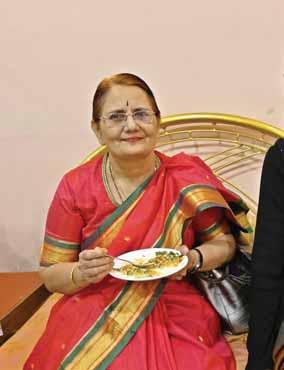
Rasheeda Bhagat
who is a member of my club and get it done. But he should not chase me for his business.”
Asked how welcoming RC Calcutta was on women’s membership, he answers: “Very much, we have inducted many women members and they are happy to be part of our club; their membership is around 10–12 per cent. And we’ve had two women presidents — Nandita Sen and Nilima Joshi. And our club secretary this year is Anusua Das.”
Memories are many, as is nostalgia. Rohatgi vividly remembers the club meeting addressed by the Dalai Lama, which went on beyond an hour of the stipulated time. “There was pindrop silence when he spoke, and nobody walked out of the hall. He had such magnetism. The same was true of Field Marshal Manekshaw, such a captivating speaker, and he talked very highly of Rotary.”
Did Rabindranath Tagore ever address their club? “Not to my knowledge. This was a very elitist club, not in a negative sense but because the

Madhavi Pandya with past president Nilima Joshi. Club President Chowdhury exchanging flags with President of RC Shanghai at Shanghai on their 100 th anniversary celebration.
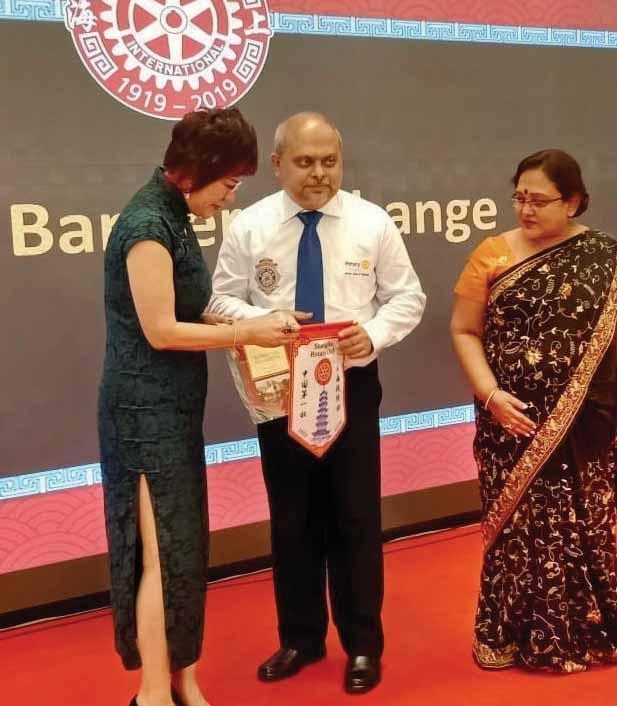
best doctors, chartered accountants, lawyers, etc were members of our club. Even then we did village uplift programmes and it was so interesting to watch all those top people doing hands-on service.”
He recalls that in the 1950s, one of the early projects RC Calcutta took up was the Garcha basti improvement. “It was then a slum area, and was also the home of Laharry. Bengal then had many Naxalites and they had a strong presence in the basti area, where we had planned the inaugural of a homeopathy dispensary. Suddenly they came with swords, daggers and sticks at us. And who should drive them back? The Rotaractor — now a Rotarian — heading our Rotaract club. He and his Rotaractors drove those people out!”
Those were exciting days when topmost professionals did hands-on service. Today too, top professionals from different sectors are there, “but they don’t want to go to a village, say for a medical project. They will send their assistants… but in the olden days every Sunday we would be there. That is something that has changed, people come here today to become our club members to improve their stature in society.”
Recalling the Begumpur and Garcha basti uplift projects of yore, for which the club got a special award from Rotary International, he says, “It was a holistic project, we put up new looms
as there were many weavers in the area. We also introduced sericulture there. It used to be like a grand picnic, we had fun, our Anns and children went with us in our cars. We talk about inclusiveness and involving our families in Rotary these days, but all that existed in the earlier years.”
Also, even before he joined Rotary in 1958, “Rotary had a certain status in the system and the province. That is why and how our club could be involved in the building of the Howrah bridge.
At that time, he explains, there was a pontoon bridge which would open up for the passage of ships. RC Calcutta lobbied with the government for a bridge at that point and “Rotary had a representative in the committee to look after the maintenance of the bridge which was then called the New Howrah bridge and for years together, till either the club lost interest or our representative didn’t turn up, he continued on that committee!”
Also, adds Rohatgi, in the earlier years either a Commissioner of Police, an ICS officer or other government officers were members of the club as well as politicians. Adds Gupta, “Surendranath Banerjee, one of the founder members of the Congress, was an honorary member of our club and attended club meetings.”
Past president of the club Dr S K Sharma, who joined RC Calcutta 30



Rasheeda Bhagat
Left: RIPN Shekhar Mehta with PDG Somendra Chandra Nandy.
Above: Club President Chowdhury with club members at a school in Bishnupur where new classrooms were constructed.
years ago, shares his seniors’ excitement about dirtying their hands in the mud, while executing service projects. Asked what he enjoyed the most about his three decades in the club, he says, “Helping people, looking after children, patients with heart diseases and so on.”
Incidentally, the first WASH project in Mityanagar in Shantiniketan was financed by Sharma. Says Ritwik Gupta, “He did that when we were distressed to find that those women were forced to go out into the open. We also gave solar lights.”
Only two persons in the area agreed to give “space in their homes for us to build toilets. Two months later, others said they wanted toilets too, specially
the women. Dr Sharma’s wife, Vijayalakshmi was very kind and had a soft spot for this project, and the couple helped to expand it.”
Over the earlier decades the club had a “very good relationship with the government. Actually, we were helping the government, and but for us Rotarians, polio would not have been eradicated from India.”
Interestingly, around 1999–2000, when the club invited the then West Bengal Chief Minister Jyoti Basu as a speaker, the Rotarians weren’t amused to hear him say “I’ve heard you people do a lot of good work.” They felt it was his business to know they did good work!
Sharma talks with passion about the villages that they have renovated, providing solar lamps, hand pumps, toilets for homes, refurbishing schools and giving furniture, books, etc to schools. “Every time we did this in one village, people from the next one would come and request us to help them. To cut a
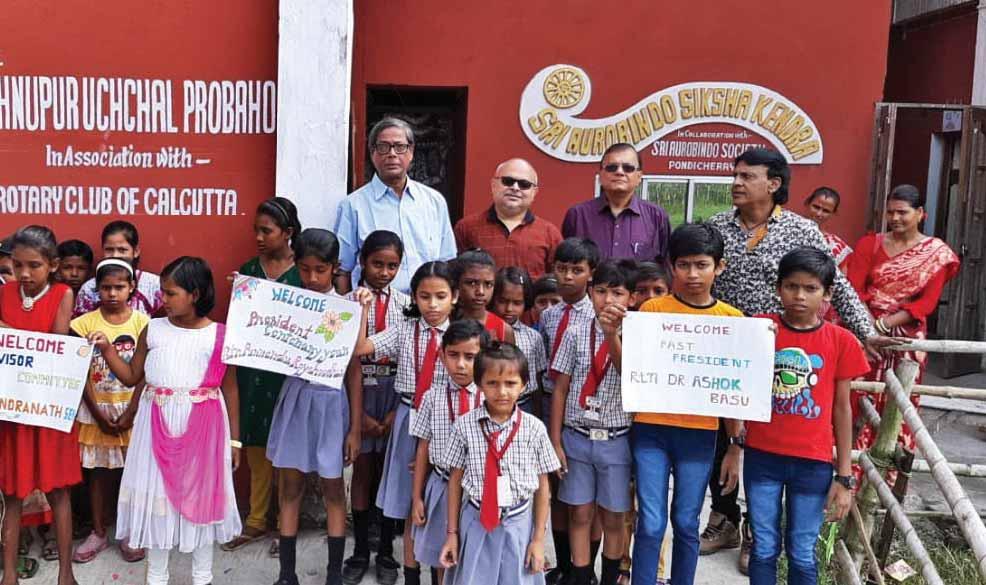
We are very choosy about who we
take. Because we don’t want anyone to
come and start his or her business here.
Purnendhu Roy Chowdhury Club President
long story short, we have worked thus in 100 villages in 100 years.”
Adds Rohatgi, “PRIP MAT Caparas from Philippines, who brought in the RCC concept, had said that once you bring up a village to a level where they can look after themselves, leave that village, and go to other villages. We did just that.”
Gupta says that in those early years, the club had “conceptualised an overall village development programme, giving them not just one or two things, but a complete package including health care, water and sanitation, vocational skills and an income stream. We have set up 10 RCCs, and President Caparas inaugurated one of them. They are very active. Apart from village development, we do a lot of health camps, support hospitals, give a lot of equipment, and so on. We are very proud of the rich history of our club.”
Nilima Joshi, a chartered accountant, is the second female president of the club (2016–17). She joined in 2001, when “there were very few women in our club. And I got to do so many things, making arrangements, taking on responsibilities… I am grateful for all the opportunities that were given to me. Three years after joining I was made a club treasurer!”
So how difficult was it to become club president? “Actually, people were badgering me for at least a few years to become president, but as my children were entering college, I delayed it!” Ask her what she loves about being a Rotarian, and she beams and says, “Everything! The work, our Tuesday
meetings, our projects… particularly the paediatric heart surgeries. When we meet the parents, they are so grateful for what we have done and give us so much love and respect.”
With pride she points out that during her year, RC Calcutta got a huge trophy for being the best club in the district… “we must have got at least 20 awards! We did a lot of work in school education and literacy, and gave e-learning kits. We still get letters from those who have used it.”
The women were fantastic as they
dared their husbands, who beat them,
or mothers-in-law who stopped them,
to come for adult literacy classes.
Nilima Joshi, past pesident

Nilima recalls that when they went to villages for adult literacy, “when we asked people do you have toilets at home, most of them looked the other way. And the women were fantastic as they dared their husbands, who beat them, or mothers-in-law who stopped them, to come for adult literacy classes. The primary motive was that this will help us do something for our children; if we learn, we can teach them.”
Club Secretary Anusua Das, who runs an engineering company, and joined the club in 2003, says she loves the challenge “of this position in such an important year as the Centennial. So many people have worked so hard to bring the club here; now it is our turn to take it forward.”
Over 100 years, generations of Rotarians in RC Calcutta have touched and changed forever lakhs and lakhs of lives. What is heartening is that the present continues to be great too. Amit Ghosh tells me about the great work done by one of their RCCs, which has left an indelible impression on his mind.
Among the skill development done by RCC is a beauty course. He recalls that in a village in Shantiniketan, while distributing blankets, he met a young Muslim woman who had undergone the course. But she was not allowed to work in a parlour and so he asked her how she made a living. “She said she had her own business; I make house calls around the Idd season. I go out at 7 am and return only at 9 pm. I have so much work.”
During that period, she earned around `20,000. When asked how she commutes, “she pointed to a man waiting nearby with a two-wheeler and said, ‘He is my husband; he takes me around.’”
The best part… “And that twowheeler has been bought with my money,” she added!
A tribute to Nitish C Laharry
Clifford A Randall
Lead, kindly Light, amid the encircling gloom; Lead thou me on! The night is dark, and I am far from home; Lead thou me on!
With these words of verse Nitish C Laharry concluded his final address to the international Convention in St Louis, Missouri in June, 1963. They were familiar words to those close to Nitish. He used them frequently.
The “home” he contemplated when he spoke these lines was not the place he called his abode at any time. Nitish was an intensely spiritual man. It was his nature and his instinct to identify the spiritual motivation which he conceived to be at the root of man’s activity and, in particular, those activities attributable to a man’s affiliation with Rotary.
This quality of the man who was the first President of Rotary International from Asia impelled him to challenge Rotarians of the world to “Kindle the Spark Within.” In his words, “By doing so we shall realise that the path to an ultimate destiny lies in the resignation of the fact that all humanity is one and that each one of us is a spark from the Divine Godhood.”
The 52 nd RI President was born in Calcutta and educated there. He was well educated. He received a bachelor of arts with honors in English from the University of Calcutta, also a master’s degree in economics and political science and a law degree. After practising law for four years he turned to the rapidly growing motion- picture business, in which he spent the rest of his working life. In 1926 he became a member of RC Calcutta under the classification “MotionPicture Distributing.” A history of the Calcutta club contains this note about Nitish: “He was appointed the first Indian Secretary of the club. Although at that time the writer knew him as a quiet, even shy, young man he was in the thick of it right from the start.”
Eighteen years later he became President of RC Calcutta, and 18 years after that he became RI President at Tokyo, Japan. Quiet, modest, sensitive and humble he has always been, throughout the 38 years he served Rotary. Yet he has always been “in the thick of it.” Space permits but one example: his part in the 1958 Asia Regional Conference held in New Delhi.
Nitish served as Chairman of that Conference described by informed men of India as the largest non-political, non-religious gathering of Indians ever held. I accompanied Nitish on a visit to the late Prime Minister Jawaharlal Nehru prior to the opening of the conference, and we invited him to join the Rotarians at a garden party closing the conference. It was a gesture of courtesy. We scarcely expected Mr Nehru would find it possible to attend a social function devoted to Rotary fellowship. However, when the garden party was its peak with 2,000 Rotarians and members of their families in attendance, Prime Minister Nehru walked into the garden, alone and unescorted, greeted the Rotarians, and joined in the conversation. It was a dramatic event and many interpretations could be placed upon it. I had my own interpretation. I felt quite certain that Nitish had indeed kindled the spark on his fellow countryman Mr Nehru, and that the Prime Minister, with equal sensitivity, was giving personal recognition to Nitish for his service, devotion and diligence.
At a time, in the evolution of Rotary, when the age-old distinctions between East and West were coming into ever sharper focus, Nitish Laharry came and walked among us as our leader. He was the living example of the fact that in truth East and West can meet. He was an inspiring symbol of his own deep belief in “the essential oneness of mankind.” And now has gone to walk with the Master. Let us all give thanks for what he was and what he gave to us. Let us reverently rejoice that the kindly Light has led our Nitish home.
The writer is past president of Rotary International (1958–59). PRIP Nitish C Laharry
Children’s Treat: RC Calcutta@100
The beginning


Rasheeda Bhagat
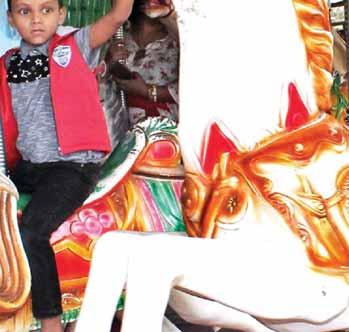


One of the most iconic and probably the longest lasting Rotary project in the world is Children’s Treat that the Rotary Club of Calcutta, RID 3291, has been doing for 95 years.
PP Ritwik Gupta, who has been deeply engaged in bringing out an updated version of the club’s history, talks with passion about this signature project of his club, which was what got him into Rotary in the first place; he joined the club in 1987.
Over a steaming cup of chai on a freezing New Year’s eve, as his club turns 100, Gupta says: “My father was a Rotarian and a member of RC Calcutta and it was from his office that a lot of work on the Children’s Treat project was being done. The person there with him was about my age; I told him you are doing this wonderful thing, why can’t I be a part of it? And he said, join us! So I told my dad I want to join your club. He talked to a Rotarian and that man took me under his wing from Day 1”
The chance to “serve, right from Day 1, keeps you inspired,” he says, adding casually: “By the way,
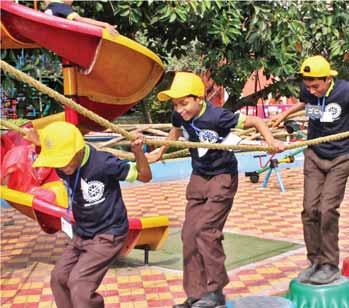

Children’s Treat started in 1925 — RC Calcutta was formed in 1920 — and we just had the 95 th session of the project earlier in December. Only during World War II, when there was a blackout, one session was missed.”
It all began, when on a Christmas day in 1925, says PP Ritwik Gupta, a few Rotarians from their club noticed some poor children begging on the streets and thought we have to do something about this. “Within a few days, they got together some children, don’t ask me from where, and gave them a day of sunshine, and we’ve never stopped doing that!” Thus began the club’s signature project Children’s Treat.
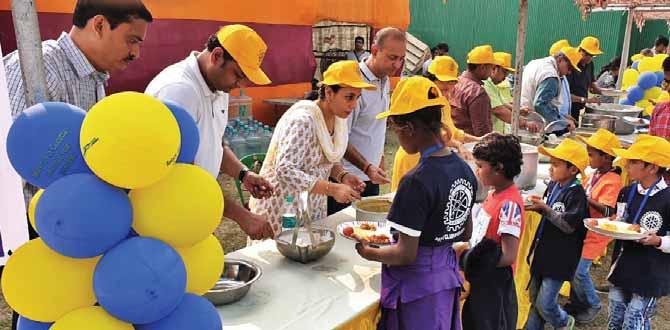
So during the Christmas season every year, members of RC Calcutta organise the pick-up of children from orphanages, non-formal schools, slum schools, put them in 25-odd buses and take them to the famous Nicco Park in Kolkata for a day of fun, food and laughter.
So how many children are treated thus?
Children’s Treat started in 1925
and we just had the 95 th session of
the project earlier in December.
Ritwik Gupta Past president of RC Calcutta

“Anywhere between 1,200 to 2,000…. We’d love to do 5,000, but it is physically not possible.” The treat begins on the bus itself where the children are given a banana, eggs, bread and juice. “We give them gifts such as a badminton racquet, a bag, T-shirt, and tickets for rides in the game park. They have fun through the morning and then come back to a designated place at lunch time,” says Gupta.
The food is prepared by cooks hired by the club inside the kitchen in the Nicco Park that is allotted to the club and typically comprises rice, pooris, sabzi and a dhal. Adds Amit Ghosh, a club member, “This year, there were 1,500 children and 300 of them were from our own Nitish Chandra Laharry Cultural Training Centre in Rotary Sadan and 350 from our RCC school, and others were from schools and orphanages in the suburbs of Kolkata.”
Apart from the vegetarian food, a single Rotarian sponsors a chicken dish for the kids.
About 70 Rotarians and their Anns, along with many Rotaractors, are involved in this project and they serve food to the children, and eat only after every child has finished his/her lunch. “After lunch there is a magic show, a band playing, and at the end of that programme we send the children off with an ice cream and gifts,” says Gupta.
He adds, “Each year, the schools decide who will go because all the children look forward to this fun event. When we send the bus, those not able to go that year, send off the others waving and saying go and enjoy yourselves!”
Ni hao, Rotarians! P erhaps the most fulfilling of all human endeavours is to give back, and Rotary offers countless opportunities to do it, such as donating to TRF. Each Rotarian and club can choose the level of Foundation giving that is right for them.
When you give $100 or more per year to the Annual Fund, you can become a Rotary Foundation Sustaining Member. Multiply that gift by 10 and you are a Paul Harris Fellow — one of those who donate $1,000 or more to the Annual Fund, the PolioPlus Fund, or approved global grants. Since 1957, there have been more than one million Paul Harris Fellows. And when Rotarians give $1,000 or more to the above annually, they become Paul Harris Society members. The Rotary Club of James River (Richmond), Virginia, is just one club that reached 100 per cent membership in the society, and your club can do it too.
Let’s multiply by 10 again. Rotarians who commit to future gifts of $10,000 or more to the Foundation join the Bequest Society. Major Donors are those who have already given $10,000 or more to our Foundation. I am still proud of how we added 106 Major Donors in Taiwan during Rotary’s centennial, exceeding our goal of 100. Together with the 103 additional Major Donors inducted the following year, they contributed more than $2 million to the Annual Fund! The gifts these donors make can change entire communities.
The Arch Klumph Society recognises the highest level of giving at Rotary, at $250,000 or more, touching hundreds if not thousands of lives for generations to come. This month, I salute the 11 individuals and couples recognised during this year’s International Assembly for increasing their giving level within the society. These generous supporters traveled from Japan, Nigeria, Taiwan and the United States to celebrate their philanthropy.
Now, imagine what your club can do, what contribution you would like to make, what legacy you would like to leave, and find a giving level that works for you. Whatever you choose to give, remember that the gifts we give today will help Rotary and the communities we serve this year, next year, and beyond, in ways we may never know.
Make hygiene and sanitation a habit
We are living through trying times. As the world comes to grips with having to confront the Covid-19 outbreak, I am reminded of Thomas Paine’s famous words “ These are times that try men’s souls. What we obtain too cheap, we esteem too lightly: it is dearness only that gives everything its value”.
Today, more than ever before, as quarantine and isolation become grim realities, we swear by sanitation and hygiene and the need for public awareness. WHO had of course flagged the need to focus on providing safe drinking water and promoting sanitation and hygiene in the century gone by. In 2017, WHO estimated that at least 2.3 billion of the world’s population was still without sanitation facilities and 884 million still lacked access to safe and clean drinking water.
The Rotary Foundation, through its WASH initiative, has been in the forefront of addressing this challenge. Since 2013, TRF has invested in many WASH stations in over 100 countries. It has also instituted a pilot programme to motivate Rotary clubs to develop a sustainable Water, Sanitation, Hygiene and Education Challenge for Schools. Five countries have been chosen for this pilot – Kenya (Africa), Guatemala, Honduras and Belize ( Central America) and India. This was in recognition of their strong, committed involvement in school sanitation efforts.
This is also part of TRF’s Areas of Focus : Water, Sanitation and Hygiene; and Basic Education and Literacy.
Mark Antony, in Shakespeare’s Julius Caesar, says “the evil that men do, lives on after them; the good is oft interred with their bones”. However, this is not necessarily true. Sophocles, one of ancient Greek’s greatest writers of tragedies said: “To be doing good deeds is man’s most glorious task.” That’s what TRF does – doing good in the world. And given the hyper connectivity in today’s world, this is abundantly acknowledged as Rotary connects the world.
Friends, stay safe and stay well.
Gary C K Huang Foundation Trustee Chair
Gulam A Vahanvaty Trustee, The Rotary Foundation






